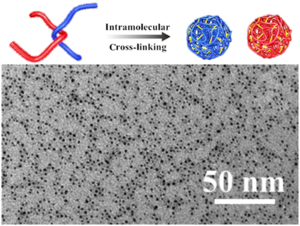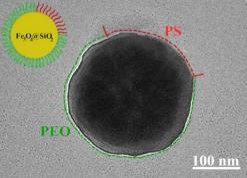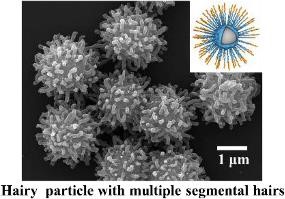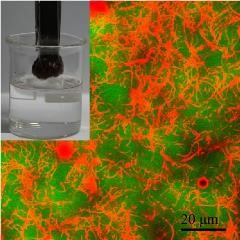1. Xiang, Dao#; Chen, Xi#; Tang, Lin; Jiang, Bingyin; Yang, Zhenzhong*. Electrostatic-Mediated Intramolecular Cross-Linking Polymers in Concentrated Solutions, CCS Chem., 2019, 1(5): 407-430.
Since Kuhn in1956 firstly proposed intramolecular cross-linking of isolated single polymerchains in diluted solutions, the method has been extensively employed to achieve single chain colloids and tadpole colloids (Janus ones) from homopolymers and copolymers, respectively. It is urgently required to develop new conceptual general methods toward the intramolecular cross-linking in concentrated solutions. After understanding that the conventional methods are based on short-ranged protections, we immediately proposed that long-ranged electrostatic mediated intramolecular cross-linking of polymers in concentrated solutions. It is key to previously introduce electrostatic repulsion via modification with mono-valence agents, and sequentially perform the cross-linking with multiple-valence agents. For the polyvinylpyridine (PVP) contained polymers, iodoethane and 1,5-diiodopentane are used as the modification agent and cross-linker. For the polyacrylic acid (PAA) contained polymers, 1-methylimidazole and 1,6-hexanediisothiocyanate are used for the intramolecular cross-linking. Polyisoprene (PI) contained polymers are selected as the cheap polymers. After click reaction with mercaptoacetic acid (MA), the polymers resemble PAA contained polymers. Intramolecular cross-linking of PS-b-P4VP-b-PEO can be cross-linked at 300 mg/mL. Composition and performance of the colloidal domains are broadly tunable by favorable growth of functional materials, and a huge family of functional composite Janus colloidal single-chains will be derived.

DOI: 10.31635/ccschem.019.20190035
https://doi.org/10.31635/ccschem.019.20190035
2. Geng, Zhen; Xiong, Bijin; Wang, Liquan; Wang, Ke; Ren, Min; Zhang, Lianbin*; Zhu, Jintao*; Yang, Zhenzhong*. Moebius Strips Ofchiral Block Copolymers, Nat. Commun., 2019, 10: 4090.
The Moebiustopology (twisted, single-sided strip) is intriguing because of its structural elegance and distinct properties. Here we report the generation of block copolymer Moebius strips via a fast self-assembly of chiral block copolymer polystyrene-block-poly(D-lactide acid) (PS-b-PDLA) in tetrahydrofuran/water mixed solvents. The Moebius strip is formed by morphological evolution from large compound micelle (LCM) to spindle-like micelle (SLM) and then to to roid with a 180° twist along the ring. Mechanism insight reveals that a subtle balance of crystallization of PDLA and microphase separation between PS and PDLA chains dominates the formation of Moebius strips. An intriguinghelix-helix transition occurs during the chiral transfer from microphase to assemblies, which is driven by relaxation of the internal stress within SLM related to orientated stretching of PS chains. Mesoporous chiral channels can be generated within Moebius strips after removal of PDLA, which are interesting in chiral recognition, separation and asymmetric catalysis.

DOI: 10.1038/s41467-019-11991-3
https://doi.org/10.1038/s41467-019-11991-3
3. Chen, Xi; Xu, Jingjing; Sun, Dayin; Jiang, Bingyin; Liang, Fuxin; Yang, Zhenzhong*. Emulsion Interfacial Synthesis of Polymer/Inorganic Janus Particles, Langmuir, 2019, 35(18): 6032-6038.
We report a method to prepare polymer/inorganic Janus particles by transferring self-assembled membranes of copolymers such as PS-b-PAA at an emulsion interface when the amine-capped particles such as paramagneticFe3O4@SiO2 core/shell particles are preferentially adsorbed by specificinteractions. While the particles are protected, the exposed side can be further modified to conjugate aldehyde-capped polyethylene oxide (PEO). Both connections become robust by covalent bonds. The hydrophilic PEO and hydrophobic PS chains are distinctly compartmentalized onto the opposite sides of the Fe3O4@SiO2 particles. As a magnetic responsive solid surfactant,the stabilized emulsions can be driven with a magnet for directional movement and coalescence with increasing magnetic strength. This method can be extended to other Janus particles with tunable organic materials and solid particles.

DOI: 10.1021/acs.langmuir.9b00211
https://doi.org/10.1021/acs.langmuir.9b00211
4. Zhang, Yang; Jia, Fan; Tang, Lin; Zhou, Peng; Jiang, Bingyin; Liang, Fuxin; Yang, Zhenzhong*. Particle Mold Synthesis of Block Copolymer Janus Nanomaterials, Macromol. Rapid Commun., 2019, 40(11): 1900067.
A particle mold synthesis of 2D Janus nanomaterials is proposed by cross-linking of copolymer self‐assembled monolayers confined within the mold domains. Onto the silica(SiO2) particle surface, mold domains with functional groups such as imidazole are generated. The model copolymer of polyacrylic acid‐block‐polystyrene (PAA-b-PS) can be preferentially absorbed onto the domains via electrostatic interactions,forming a self-assembled monolayer. In a cosolvent such as tetrahydrofuran (THF), the crosslinking occurs within the whole of the PAA side. A Janus disc is thus achieved after detachment from the particle upon breaking the specificinteraction. In a poor solvent, the cross-linking slowly occurs from the periphery, giving Janus nanorings. The rings evolve into discs with further cross-linking. The mold particles can be recycled to synthesize the same 2D Janus materials.
https://doi.org/10.1002/marc.201900067
5. Wan, Jinping; Lv, Dongmei; Cui, Shuqin; Liang, Fuxin; Yang, Zhenzhong*. Synthesis of Hairy Composite Particles, Polymer, 2019, 172: 247-252.
Hairy composite particles with polymer nanoscale hairs are grown by precipitated cationic living polymerization onto a particle surface. Composition and length of the hairs are tuneable. The hair growth is general following the tip-growth mode. By step polymerization of varied monomers, multiple segmental hair sare achieved onto a particle surface. As an example, the PEG-conjugated PVBC-PDVB@Fe3O4 hairy particle is derived. It is highly effective to capture oil from the aqueous surroundings and easily recycled with a magnet.

DOI: 10.1016/j.polymer.2019.03.071
https://doi.org/10.1016/j.polymer.2019.03.071
6. Meng, Hongyu; Wan,Jinpin; Jing, Jingyun; Sun, Dayin; Jiang, Bingyin; Liang, Fuxin; Yang, Zhenzhong*. Magnetic Responsive Polymer Nanofiber Composites for Easy Collecting Chemical Spills, Chinese Chem. Lett., 2019, 31(1): 253-255.
We describe a simple method to prepare magnetic responsive polydivinylbenzene(PDVB) nanofiber composites by precipitated cationic living polymerization in the present of oleic acid capped Fe3O4 nanoparticles (NPs). TheFe3O4 NPs are encapsulated with the PDVB forming dendrites, from which thin nanofibers are grown in the tip-growth mode. The thin nanofibers are interwoven with the thick nanofibers forming robust composite network. The composites are magnetic responsive and highly efficient to gel almost all chemicals. Separation of the gelled chemicals from water becomes easier with a magnet. The performance is promising for magnetic collection of chemical spills.

DOI: 10.1016/j.cclet.2019.04.002.
https://doi.org/10.1016/j.cclet.2019.04.002
7. Si, Yan; Ji, Xuyang; Liang, Fuxin*; Jiang, Bingyin; Yang, Zhenzhong*. Responsive Janus Cage Reactor, Chem. Asian J., 2019, 14(11), 1917-1920.
A Janus silica cage was synthesized by selectively grafting an ionic liquid (IL)and poly-N-isopropylacrylamide (PNIPAM) (lower critical solution temperature(LCST)≈32 °C) onto the exterior and interior sides of the mesoporous SiO2 shell. The paramagnetic core inside the cavity is responsible for magnetic collection. The PW12O403-anion is further conjugated onto the IL side by anion exchange. The Janus cage acts as a thermal-responsivereactor for catalytic oxidization of dibenzothiophene (DBT) in the presence of H2O2. The sulfide in the model oil can be completely decomposed at 25 °C,whilst the oxidative products are more dissoluble in water and preferentially captured inside the Janus cage. The Janus cage reactor could be regenerated at high temperature above 32 °C after releasing the products.
https://doi.org/10.1002/asia.201900173
8. Yu, Xiaotian; Sun, Yijing; Liang, Fuxin*; Jiang, Bingyin; Yang, Zhenzhong*. Triblock Janus Particles by Seeded Emulsion Polymerization, Macromolecules, 2019, 52(1), 96-102.
Triblock Janus particles are prepared by two-step seeded emulsion polymerization against eccentric polymer hollow particles. Two silica bulges are sequentially grown at the eccentric zone transiting from the thick shell to the thin shell. The angle between the two silica bulge axes is tunable within 0–180°, determined by the eccentricity degree of the PS/PDVB hollow seed particles. The two silica bulges and the PS/PDVB domain of the triblock Janus particles can be selectively modified to enrich composition and functionality. As an example, the paramagnetic PS/PEO modified triblock Janus composite particle can serve as a functional solid surfactant to manipulate emulsion droplets with a magnet and deliver desired materials toward the interface.

DOI:10.1021/acs.macromol.8b02101
https://doi.org/10.1021/acs.macromol.8b02101